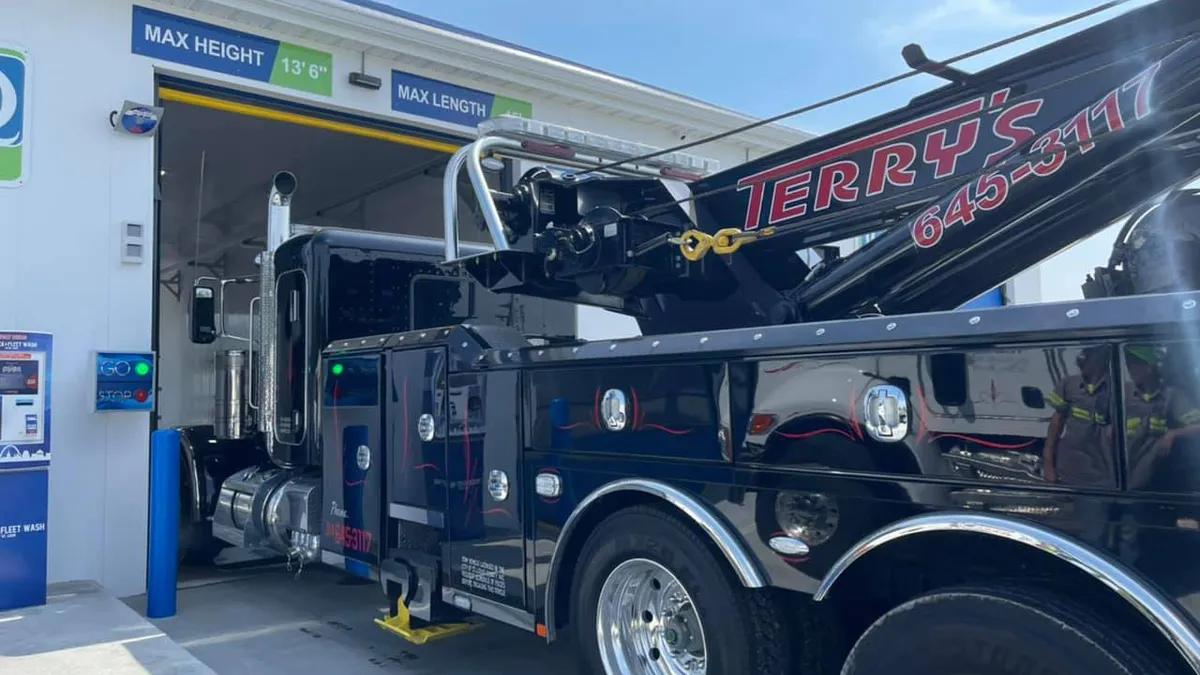Recently we’ve seen coverage sprouting in trade media, newsletters and industry blogs referring to a transformation underway in the travel center, truck stop and C-Store industries. Perhaps you’ve noticed buzzwords like overhaul, upgrade, enhanced services and expanded selections sprinkled in these stories and reports. In this article we address one facet of the transformation trend that is often overlooked or underplayed yet quite possibly offers the greatest potential for growth.
Background
For years, fleet operators and independent truckers have faced the daunting challenge of keeping the exterior of their vehicles clean on a consistent basis. The difficulty stems from three key factors:
-
Limited Options. Fleet size and geographic disbursement determine the feasibility of certain options. Typically, only those over 100 vehicles with a central terminal invest in on-site truck wash equipment. Both large and smaller fleets may contract for mobile wash service to provide scheduled on-site cleaning. Hand washing by fleet employee(s) or independent driver is not uncommon and a commercial truck wash facility is a frequent choice of fleets and drivers.
-
High Costs. Each option has distinct cost components that contribute to the actual expense incurred per wash. These include capital cost for on-site equipment, fees and surcharges for mobile wash service, wages and supplies for handwash, prices and downtime of commercial washes. Analysis of all components reveals the true cost per wash for semi’s range from $85 - $190.
-
Inefficiencies. Fleets with an on-site wash benefit from its efficient and consistent operation. On-site mobile service entails internal admin, oversight and security overhead. Hand washing is time consuming and labor intensive. Most commercial truck washes are also manual operations and with far fewer locations per vehicle compared to standard car washes demand far exceeds supply. This combination of slow wash process and long wait times spell added downtime and reduced efficiency. Stationary or idling trucks are the bane of the industry.

Demand drivers
To assess the demand for exterior truck washes we first identify the primary motives and benefits of maintaining a clean vehicle for the owner.
-
Care & Prevention Road salt and chemicals, grime, insects, snow and ice all are detriments to vehicle condition, performance and safety. Removing these impediments with regular cleaning helps maintain asset value and prevent potential hazards.
-
Fuel Economy. Allowing layers of road grime to build up on a large vehicle adds significant weight over time as well as inhibiting the vehicle’s aerodynamics. Washing trucks frequently helps improve mileage.
-
Brand Standards. Clean trucks reinforce the operator’s brand image and reputation in a highly visible manner.
-
DOT Deterrence. Perhaps the strongest motive for truck cleanliness is to reduce the risk of DOT scrutiny. In theory, a filthy vehicle may suggest an operator’s lack of commitment to safety and regulatory abidance and thus be far more susceptible to DOT inspection.
Opportunity
Now that you have a framework of Truck Wash supply and demand, let’s explore the opportunity this presents as part of the transformative trends in our industry. Specifically, what are the current metrics that now more than ever warrant adding or upgrading a commercial truck wash to your business?
According to Census Bureau and Industry data, there are approximately 4,200 standard-size vehicles per car wash in the US while the ratio is 12,000 large vehicles per commercial truck wash.

Further, the typical car wash costs $13.00 and a commercial exterior truck wash prices often exceed $120 for a semi.
Together these stats suggest a potential golden opportunity were it not for a couple of caveats. Previously we mentioned most commercial truck washes are manual operations, meaning a team of up to six employees use long wands, hoses and brushes to clean the vehicle. The process is slow which limits throughput to barely a single truck per hour (or longer). Ongoing labor shortages have made staffing difficult and increasingly costly. So, where’s the gold?
Recent innovations in truck wash equipment and technology have countered the caveats and added new luster to this golden opportunity. The game-changer among these is the introduction of in-bay automatic wash systems for large vehicles. Also referred to as roll-over type washes, these are essentially adaptations of a traditional category of car wash models to accommodate up to Class 8 size. Not only do these machines replace hand labor, they also function autonomously meaning trucks can be washed 24/7. What’s more, this new breed of truck wash can clean up to four semis per hour.
Bottom line
Is the time right to invest in a truck wash with no employees, high capacity, low cost per wash and dramatic competitive price advantage?
The chart below illustrates the golden ROI potential of a fully automatic truck wash system versus a standard manual type wash. The example compares the latter with the IQ MAX in-bay automatic from D&S Car Wash Supply and calculations are based on maximum volume capacity of a single bay for each type. (Note: this model is broadly representative. All information is intended solely as a general reference and (a) neither implies or guarantees actual results, or (b) shall not be construed as an equipment quote or proposal.)











